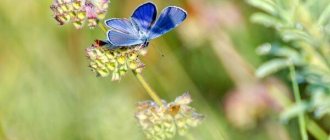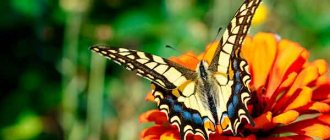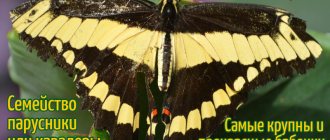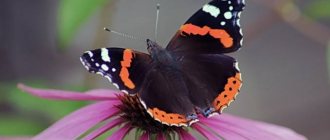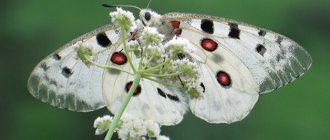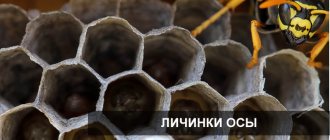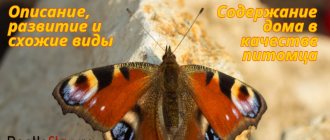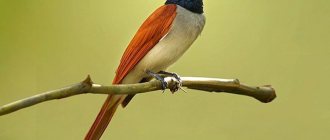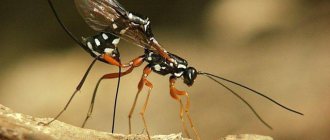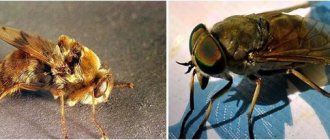Nature has many creatures of amazing beauty and grace. One of them is a bright peacock butterfly. It is easy to distinguish it from other representatives of the order Lepidoptera by its characteristic pattern. On the wings there are four blue eyes with a dark border. The insect lives throughout Eurasia and can easily be found in early spring in a garden or park. The butterfly feeds on plant nectar and gives preference to buddleia, a shrub with white or lilac fragrant flowers.
Description of the species
The beauty of butterflies invariably attracts the admiring glances of fauna lovers. The photo shows one of the amazing creations of nature, the peacock butterfly. She is a typical inhabitant of garden plots and forest clearings. Prefers free, well-lit areas rich in flowering vegetation. In dense forests, she runs the risk of damaging her scaly wings on tree branches.
Insect taxonomy:
- family - Nymphalidae;
- genus – Aglais (urticaria);
- species – Inachisio Daytime peacock eye.
The family of nymphalids is characterized by variegated wing colors on the outside and protective colors on the inside. Many of its representatives tend to migrate in search of better food places. The genus of wrens is not numerous, it includes only 6-7 species, including the day peacock butterfly.
Information. The history of the Latin name of the species is associated with Greek mythology. Inachis is the name of the river god Inach, Io is his beautiful daughter.
The peacock eye is not large in size, the length of its front wings is 30 mm, the span is 60-62 mm. The wings are wide, the outer edge with serrations and angular projections. Their main background is reddish-brown or red. A grayish-brown stripe runs along the edges. At the top of the front and rear pairs of wings there is a characteristic pattern in the form of an eye with a blue center. It is surrounded by yellowish, white and black rings. In the description of the peacock butterfly, one should note the protective coloring on the underside of the wings. On a dark background, light brown sinuous lines create an imitation of a dry leaf.
Interesting fact. The color intensity is affected by the temperature at which the pupa developed.
The head is round, the mouthparts are of the sucking type, with a proboscis. The antennae are club-shaped. The eyes are complex, faceted, and shaped like hemispheres. The chest consists of three segments. The front legs are reduced. They are not used when walking; insects move on their middle and hind legs. In the middle of the front shin there is a spur for cleaning the antennae. Sexual dimorphism is manifested in the structure of the antennae and size - females are slightly larger than males.
Fighting methods
Due to the great environmental damage these insects cause, many methods have been developed to combat them. Highlight:
- methods associated with the use of chemicals;
- methods associated with mechanical methods of control;
- traditional methods to destroy harmful organisms.
Each of them has its own advantages and disadvantages, which are worth considering separately.
Specialty Chemicals
The use of specialized chemicals involves the use of:
- neonictinoids;
- organophosphorus compounds;
- pyrethroids.
They are sold in agricultural stores and used according to the instructions specified by the manufacturer. Advantages of the method:
- efficiency;
- you don't need to spend a lot of effort.
Minuses:
harmfulness.
Mechanical methods of control
Unlike chemicals, mechanical methods are harmless to the environment and humans, but are extremely energy intensive. They take a lot of time and effort. Mechanical methods include:
- Removing caterpillars manually by collecting and further destroying them.
- The use of special adhesive belts that prevent the movement of adult insects and caterpillars along tree trunks.
- Destruction of pupae that are concentrated in one place in large quantities.
Folk remedies
Folk remedies are less effective than their chemical counterparts, but they do not harm the environment. Folk remedies include:
A decoction based on hot pepper.
Pour one hundred grams of chopped pepper with one liter of water. Boil for an hour, then let the broth brew for two days. Mash the pepper and strain. Add half a glass of broth to 10 liters of liquid, then spray the plantings with it. To better retain the liquid on the surface, add a little soap to the solution.
Powder made from tansy.
Dry the tansy and grind it to a powdery state. Sprinkle the resulting powder onto plants that need protection.
A decoction based on burdock leaves.
Finely chop the leaves and place them in a large container. A bucket is best suited for these purposes. Fill the container with leaves to a third of the total volume. Fill with water. Let it brew for three days, after which we spray it with the strained decoction of the plant.
Habitat
Butterflies are widespread throughout Europe, Asia and Japan. In the north, the distribution is limited to a latitude of 60°. In Eastern Europe it is found in all countries, with the exception of the far north. You cannot find a peacock's eye on the island of Crete and northern Africa. Insects settle wherever there are flowering plants: in forests, on forest edges and clearings, in ravines, on the banks of reservoirs. In urban areas they appear in parks, squares and gardens. Butterflies live in the mountains, climbing to heights of up to 2500 km above sea level.
Information. The place where the largest concentration of peacock butterflies is located is Germany.
Harm to plants
It is a fairly common belief that peacock butterfly caterpillars cause damage to garden and vegetable crops. Therefore, some gardeners destroy them along with other pests. However, neither larvae nor adult butterflies of this species pose any threat to plantings.
Quite the contrary - butterflies pollinate many of the plants growing in the garden, and caterpillars eat nettles, which interfere with the growth of crops. The only garden crop on which peacock eye caterpillars can be found is raspberries. But insects do not cause any significant harm to the plant.
Lifestyle
The main method of movement of butterflies is flight. It can be active with flapping wings or passive - gliding. Sometimes insects make long flights in search of food. What does the peacock butterfly eat? Like most lepidopterans, it sucks nectar from flowers. Among the insect's taste preferences:
- dandelions;
- marigold;
- elder;
- clover;
- marjoram;
- buddleya.
In addition to nectar, they consume the sweet juice of slightly rotten fruits and drink secretions on tree bark.
Peacock's eye is a diurnal butterfly that is active during daylight hours. In mid-latitudes, one generation is replaced per year; in the south, two generations manage to develop. The first generation of adults appears in June-July, the second in August-September. How long does a peacock butterfly live? Among insects, she is a long-liver - her life span is almost a year. The butterfly spends a significant part of the cycle in a state of suspended animation or hibernation.
Butterfly wintering
One of the notable features of the butterfly is its wintering in the adult state. With the onset of cold weather, representatives of the second generation look for reliable shelters for the cold season. They hide in the forest floor, under the bark of trees, in the cracks of outbuildings, and in attics. By folding their wings, insects fall into suspended animation, their life processes slow down. In winter, butterflies find themselves defenseless against attacks from predators; if there is insufficient accumulation of nutrients, they can die of starvation. Premature rise in temperature is dangerous. During the thaw, the peacock's eye wakes up and leaves its shelter. The second time it is more difficult for the insect to settle down for the winter.
Defense mechanism
Butterflies have many natural enemies, these include birds, rodents, reptiles, and large insects. To frighten the enemy, the peacock's eye has an unusual coloring. When attacked by birds, the butterfly suddenly opens its wings. The appearance of widely spaced eyes disorients the predator, and in some cases forces it to retreat. Even a short delay is enough for an insect to escape from the enemy.
Hearing organs
Butterflies hear through their abdomen, since their “ears” are located in the dimples on the sides of the third segment of the chest or the first segment of the abdomen.
The “ears” of butterflies are formed by a thin leathery membrane, which is stretched over a ring. Beneath the membrane are bubble-like tracheas, and nerves connect to them. When the sound wave reaches the butterfly, the membranes begin to vibrate. The tracheal vesicles pick up this vibration and transmit it along the nerves to the brain, which decides what to do.
Reproduction
Butterflies exhibit complex forms of courtship in the form of flights and mating dances. Males divide the territory into separate areas, where they wait for incoming females. After wintering, butterflies appear in early spring, and they are the ones who produce the first generation. The search for partners is facilitated by the distribution of pheromones. After fertilization, the female lays 100 to 300 eggs on the underside of the leaves of food plants. Most often it is nettle. Laying begins in early May. The embryo matures for one to two weeks, then the caterpillar appears.
Information. Young larvae live in large groups; on one nettle bush there can be up to 150 voracious individuals.
Caterpillars are equipped with gnawing type mouthparts; they feed day and night with short rest breaks. At the first instar, the length of the larvae is about 2 mm, in the second it is already 8 mm. They grow quickly, eating all the leaves on the plant. In addition to nettles, insects settle on raspberries, hops, willow or birch leaves. The number of days between molts varies; in total, caterpillars go through five instars. The larval stage takes about a month. Before pupation, the caterpillars crawl in different directions.
The larvae have their own defense mechanisms. When attacked by predators, they take a threatening pose and begin to simultaneously move in different directions. This scares off the attacker. In addition, the caterpillars secrete an unpleasant green liquid and can curl up into a ball and fall to the ground. The angular, grey-green or brownish-gold colored pupa can be seen on walls, branches or stems. The color depends on the location chosen for pupation. This stage, depending on the ambient temperature, lasts 2-3 weeks.
The length of the pupa is 25-28 mm, it is formed upside down. The rudiments of wings, proboscis, and abdomen are visible. The first generation of butterflies appears at the end of June. The cocoon ruptures along the head and the leading edge of the wings.
Information. Natural enemies of caterpillars are parasitic flies Sturmiabella. They infect larvae by laying eggs on food plants. Some species lay eggs directly into the body of the caterpillars. Fly larvae eat the body of butterflies when they are in the pupal phase.
Unique wing structure
If you look at a butterfly, you can see a network of veins on the wings. In each family they form a specific pattern. The veins serve as mechanical support for the wing. They contain air and blood.
The entire wing, like a tile, is covered with tiny scales, which can vary in size. One wing can have up to 1 million scales.
The scales contain different pigments. Differently colored scales create a bright and unusual coloring of the wing. The caterpillars also store dyes when they feed on plants.
There are colorless flakes - these are optical flakes. They refract white light and create various light effects: silvery spots and stripes in mother-of-pearl pearls, azure-blue coloring of blueberries, metallic shine, green tints and others.
The scales not only give the butterfly different colors, but also facilitate its flight and protect it from the cold.
Related species of butterflies
Butterflies of the peacock-eye family have similar wing colors and eye patterns. These are large insects with a wingspan of 12-15 cm. They are active in the dark. A distinctive feature of the family is its reduced oral apparatus. Insects do not feed at the adult stage. They live off the nutrients accumulated by the caterpillar.
Great night peacock eye
The pear peacock eye or saturnia is a butterfly common in Southern and Central Europe, the Caucasus and Asia Minor. The wingspan is up to 155-160 mm, one wing is 55-70 mm. This is the largest nocturnal butterfly in Russia and Europe. At dusk or mistaken for bats. Females are larger than males, they have short comb-like antennae, and the proboscis is underdeveloped. The main color of the wings is grayish-brown. There is a black stripe at the base, the edges of the front and rear pairs have a light border. Almost in the middle of each wing there is a visible ocellus with a dark center and a light ring.
The summer time of the night peacock butterfly is May-June. This is a heat-loving species that does not tolerate frost. They can be found in North Africa, Turkey, the Mediterranean, southern Europe, the Caucasus, Iran, Syria. Their habitats are forests and parks with a lot of bushes. Females are sedentary, males are much more active, flying even during the day. But females live almost 3 times longer - 20 days versus 8. The favorite food tree of Saturnia caterpillars is pear. But they happily feed on cherries, apples, plums, quinces, almonds, and maples. The caterpillar grows up to 10 cm and changes color several times during its life. The large peacock eye produces one generation per year; the pupa goes to winter.
Attention. The pear peacock eye is listed in the Red Book of Ukraine. In Russia it is protected in the Voronezh, Rostov and Belgorod regions.
Lesser night peacock
The small peacock eye also belongs to the genus Saturnia. Unlike the great peacock's eye, it is found throughout the Palearctic. Wingspan up to 60 mm. The male has reddish-gray forewings and orange hindwings. Females have a more modest coloration of light gray. The pattern is represented by wavy lines and bands of dark brown and yellowish color. Each wing has an ocellus - the middle is dark, the border is black and light.
Adults do not feed and live 3-4 weeks. Caterpillars live on thorns, raspberries, blackberries, willows, birches, and heather. The larvae have to stock up on food for the pupa and butterfly. The insect overwinters at the pupal stage, and begins to fly in April-May.
Organs of smell and touch
The antennae serve as the organs of smell for butterflies. The larger the antennae, the better for the butterfly. Sensitive cells of the sensilla are located on the antennae. For example, moths have more than 100 thousand of them.
Olfactory sensilla are present on the labial palps and on the hind legs. The butterfly tastes the food with its feet. If a butterfly gets its hind leg into a sugar solution, it will immediately open its proboscis and begin sucking the sweet liquid.
With the help of antennae, moths detect the smell of opened flowers and individuals of the opposite sex. Scientists have found that males can sense females at a distance of 16 kilometers.
Most butterflies use their antennae to detect sound waves and mechanical shocks.
Sensitive hairs are located throughout the butterfly's body. They are connected to nerve endings that transmit signals to the brain. Therefore, any touch to its body is quickly registered in the brain, and the butterfly instantly feels pain.
How to care for a peacock butterfly
Some wildlife lovers bring insects home. Someone wants to watch the changing stages of their development or just have a piece of beauty at home. It's interesting to grow a butterfly from a caterpillar. It is placed in a container or jar and fed with leaves. When the time comes to pupate, you will need soil. The newly born individual will need time to spread its wings. What to feed a peacock butterfly at home? The insects' diet includes flower nectar and fruit juice. In the warm season, you can bring fresh flowers picked from the area every day.
In winter, it will not be possible to provide the butterfly with nectar, and in a warm apartment it will not hibernate. Flower nectar is an excellent substitute for honey solution. The natural product is diluted with water in a ratio of 1:10. The insect is taken by the body and placed on the edge of a saucer with syrup. The menu includes fresh fruit. An orange, a ripe pear, a banana are cut into pieces and offered to the pet. You will need 1-2 feedings per day. Peacock's eye can be forced into suspended animation. You will need a plastic container with holes for ventilation. In such a house, the insect is taken out to the loggia, where it is dry and cool.
The average lifespan of a peacock butterfly is 3-6 months; with good care, it will delight you with its beauty for a long time. If you plant nettles on your property, there is a real chance of seeing fluttering butterflies every day.
Features of biology
Aberration semi-ocellata
Develops in one generation in the steppe and forest-steppe zones; in Crimea and Ciscaucasia - two. Butterflies emerge from their pupae in early June. Adults are often found on flowers of greenweed, thyme, Scabiosa ochroleuca
(genus Scabiosa),
Cirsium hetcrophyllum
(genus Bodyak), felt burdock and various garden plants. Sometimes they are found on leaking tree sap or fermented fruit.
The first generation flies from late June to mid-July. The second generation flies from August to September, wintering in protected places. Females of the second generation are found until the end of October, overwinter and are found again in early spring until early June. Overwintering individuals can be found in winter during thaws. In the southern regions it can produce three generations.
How to deal with meadow moth on the site
What measures to combat the meadow moth should a summer resident take to reduce damage from the pest’s activities?
Since this butterfly hides on weeds in winter, the less attention you pay to current weeding, the greater the risk of encountering the pest next year.
Moreover, caterpillars that feed on weeds such as field bindweed, quinoa, white pigweed, and acorn grass, which develop more actively and freeze out less in the cold season. Therefore, if you promptly get rid of the above-mentioned weeds, you will simply deprive the caterpillars of a significant portion of their food.
The greatest damage to young plants and planted seedlings is caused by the first early spring generation of the moth. In the dry and hot May weather, the appetite of the caterpillars increases sharply and they begin to intensively feed on the juices of garden plants.
To prevent the appearance of moths on the site during this period, I advise destroying weeds not only on the site itself, but also along its perimeter, along the fence and greenhouse. It is better to have time to do the work before the beginning of summer and the invasion of butterflies. You can also eradicate weeds using drugs like Hurricane Forte or Glyphos.
After contact with weed leaves, the active ingredients of such preparations penetrate into all parts of the plants, causing their complete death. Within a week or a week and a half, the first effect of their action appears - the weeds gradually turn yellow and wither, and after a month they die completely.
The use of herbicides has an obvious advantage over conventional mowing. After all, when a female meadow moth does not find a suitable place to lay eggs, she simply flies a little to the side. If you use a herbicide, then they manage to lay a clutch, but the larvae that emerge from the eggs are deprived of the necessary nutrition and quickly die.
Other agrotechnical measures to combat the meadow moth include digging between rows, regular loosening and hilling of plants. Such complex measures can reduce the pest population by 1.5-2 times. Young larvae and caterpillars, being covered with soil, do not have the strength to get out and suffocate.
To protect the plantings from the meadow moth, it is useful to plant them with beans. The fact is that the hard and sharp hairs that cover the leaves, stems and petioles of beans pose a mortal danger to the caterpillars of the pest.
But during periods of the most active moth reproduction, agrotechnical methods are not enough. How to determine when it is time to resort to the help of heavy artillery? Calculate the average number of caterpillars per square meter of garden. If it is 5 or higher, then it’s time to sound the alarm.
In this case, insecticides like Kinmiks or Fufanon are used.
Such a well-known biological product as Lepidocide, which is used on vegetable and green crops even 5 days before harvesting, also works quite well against the caterpillars of this type of butterfly. However, remember that since this drug belongs to the biological class, it is used only at temperatures not lower than +13 degrees. Insecticides are sprayed not only on the vegetable plants themselves, but also on the grass along the edge of the site, if it is infested with moth caterpillars.
Keep in mind that if a meadow moth has started to take over your gardening neighbor’s plot, then very soon he will visit you. Therefore, we need to fight this pest together and systematically, helping and supporting each other in this difficult matter. This will protect the crop of the current season and significantly reduce the number of pests next year.
Winged pests in garden beds
Vegetables occupy a significant place in the human diet. The balance of our diet depends on their quality and quantity. And any summer resident always wants to get rid of butterflies in the garden in order to preserve the harvest in full.
Fall armyworm
With the onset of dusk, the active summer of the winter armyworm begins. To lay eggs, dark brown females choose plants in open spaces; butterfly clutches can be found on strawberries. During a season, one individual can lay up to 2000 eggs (10-30 eggs in one place).
The development of caterpillars takes 24-30 days, after which they burrow into the ground. By digging a depression up to 6 cm, they pupate. The second generation caterpillars also overwinter in the ground (up to 20-25 cm). After the soil warms up, they rise to the surface of the earth. Mass emergence of butterflies is observed in May.
Acacia moth (legume)
A light yellow butterfly with medium-sized fore wings (span - 25-30 mm), the hind wings are grayish in color. The female moth lays 100-600 greenish-yellow eggs. In 110-120 days of life, the acacia moth manages to make 2-3 clutches. After 4-21 days (depending on the generation), caterpillars with pink bodies and a yellow shield appear.
Depending on the air temperature and nutrition, the caterpillars develop within 20-40 days. Pupation occurs on the ground, sometimes caterpillars form cocoons at a depth of 2-5 cm, strengthening them with particles of earth. Moth moths appear after 12-15 days.
Onion moth
A small butterfly of light gray or chocolate color with wings measuring 11-15 mm. The female lays 60-80 eggs in the area of the neck of the onion or on shoots. A week later, caterpillars appear, eating the inside of the onion.
After 15-20 days, pupation begins. During the growing season, usually 2-3 generations have time to mature. The age of onion moths is observed after 10-20 days.
Cabbage scoop
The spotted gray-brown wings of the cabbage cutworm reach a span of 35-60 mm. It flies mainly at night. At the same time, the female lays 40-60 (up to 700 per season) eggs.
Adult caterpillars (body size up to 25-30 mm) are ready for pupation. They make cocoons by burrowing 8-10 cm into the ground. In the spring, the butterfly flight begins.
Cabbage moth
The sickle-winged butterfly with wings of 15-18 mm causes great damage to field crops. The light brown female lays 100-300 eggs, grouping them in groups of 4-5. A week later, caterpillars appear, which molt 3-4 times during their development. In search of fresh greens, they can crawl into beds with radishes.
Adult caterpillars (body length - 11 mm) pupate, attaching a cocoon to the back of the leaf. The moth's flight begins in 35-40 days. During the summer season, (depending on the climate) from 2 to 10 generations of cabbage moths can develop.
Cabbage white (cabbage)
Large butterflies with powdery white wings (span up to 60 mm) and dark rims along the edges. The females have large black spots on their wings. Female individuals lay 100-300 ribbed, lemon-yellow eggs.
The voracious caterpillars appear on days 6-8; they often crawl onto neighboring plants. Before the butterflies emerge, they remain in the chrysalis for 8-17 days. During the summer season, 2-4 generations of cabbage may appear.
exclamation scoop
A large butterfly (body length 30-40 mm) with large brown-brown wings (span 32-45 mm). The color of the male is lighter - from yellow-brown to gray-yellow. At the top of the wings there are two round black spots, at the base there are wedge-shaped wide stripes, the outlines of which resemble an exclamation mark.
The female lays eggs on fallen leaves. The eggs are ribbed, translucent with a greenish tint (diameter 0.7-0.9 mm). After 12-14 days, yellowish-white caterpillars appear (the length of an adult is 30-40 mm). Over time they turn red. A black stripe stretches along the back, which forms small triangles on each segment of the caterpillar's body.
Yellow-brown pupae (cocoon length - 12-14 mm) are equipped with sharp spines, and there are two tubercles on the sides. They overwinter in fallen leaves or in the surface layers of the soil. The adult caterpillars (4th-5th generation) remaining for the winter can go deeper into the surface layers of the soil (up to 10 cm); the butterfly flight begins at the end of May.
Total number
The order Lepidoptera undoubtedly stands out among taxa of a similar rank in terms of species diversity. Lepidoptera are one of the largest groups of insects, including, as of August 2013, 158,570 species, including 147 fossil taxa. It is estimated that up to 100,000 species remain still unknown to science and, thus, the total number of lepidopteran species existing on the planet can be estimated at approximately 200,000 - 225,000 species. There are 2,166 genera and 8,879 species found in Russia.
Lepidoptera are very diverse, and most of their species are poorly studied. Some of the described species are known from finds from a single locality or even from a single specimen. A true estimate of the total number of species in existence will never be known because many species became extinct before they were discovered. The taxonomy of butterflies presented in various works reflects the different views of their authors and is, without a doubt, debatable.
There are disputes regarding the systematic position or the need to maintain the status of certain subspecies or species. DNA studies suggest that some of the currently known species must be separated. A well-known example is where the seemingly identical Colias alfacariensis and Colias hyale, previously thought to be one species, were split into two after significant differences in the structure of their caterpillars and pupae were discovered.
Poisonous caterpillars
Coloring allows you to distinguish a poisonous caterpillar from a “peaceful” one. The brighter the color. It is all the more likely that the caterpillar is poisonous.
Contact with it for a person can cause teething, redness of the skin, shortness of breath, various pains and develop diseases.
- Coquette caterpillar. Lives in Mexico. Very similar to a hamster. Fluffy brown beauty 2-3cm long. on contact may cause chest pain and shortness of breath.
- Saddle caterpillar. It has a bright color: the back is poisonous green and has a large brown spot in the middle. The head and end of the abdomen are brown with thick horns. There are coarse hairs on the body. There is strong poison at the ends of these hairs.
- Lazy cleaver. Lives in Uruguay and Mozambique. The caterpillar is small in length, 3-4 cm. It is black and white in color with green tufts of stiff, milky-green hairs. Its poison can disrupt the nervous system and cause bleeding of internal organs.
- Burning rose. The main color is yellow, with red and blue stripes. Thick horns have spikes with poison. Upon contact, the spines break off and a rash appears on the skin.
Features of biology
Aberration semi-ocellata
Develops in one generation in the steppe and forest-steppe zones;
in Crimea and Ciscaucasia - two. Butterflies emerge from their pupae in early June. Adults are often found on flowers of greenweed, thyme, Scabiosa ochroleuca
(genus Scabiosa), Cirsium hetcrophyllum
(genus Bodyak), felt burdock and various garden plants. Sometimes they are found on leaking tree sap or fermented fruit.
The first generation flies from late June to mid-July. The second generation flies from August to September, wintering in protected places. Females of the second generation are found until the end of October, overwinter and are found again in early spring until early June. Overwintering individuals can be found in winter during thaws. In the southern regions it can produce three generations.


